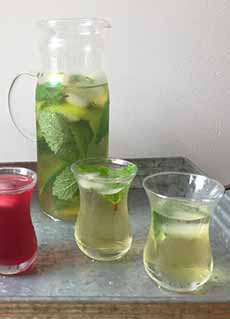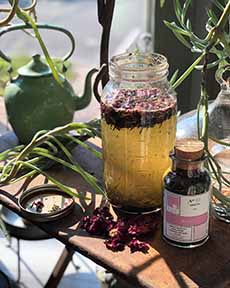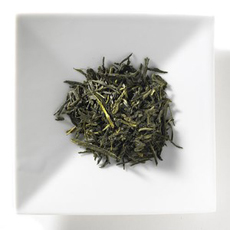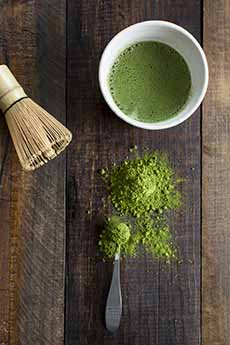TIP OF THE DAY: Green Iced Tea & Types Of Green Tea
|
We spent much of yesterday sipping on ice-cold green tea, with lots of fresh mint. We had an overabundance of mint from the farmers market, and couldn’t think of a better use than iced tea (mint works equally well in black, green, herbal and white teas). To add fresh mint* or other herbs to tea (try fresh organic lavender, rosemary or sage), crush the leaves and stems lightly in your hand to release the essential oils, before adding the mint to the tea. You can make cold brew green tea in the fridge. Tay Tea, one of the nation’s finest artisan tea blenders, offers plain bancha, matcha and sencha green teas, as well as these proprietary blends: There are different types of plain green tea, based on how the picked leaves are treated. Thanks to Ito-En for the details. Sencha Green Tea: The most well-known variety of green tea, sencha is made from the leaves (photo #5) that are steamed and rolled (photo #4). Fukamushi Sencha: Steamed approximately twice as long as regular sencha, fukamushi means “steamed for a long time.” The extra steaming provides a stronger taste and darker green color, and it lacks the grassy aroma and astringency of sencha. Gyokuro Green Tea: A special production where the tea bushes are covered with cloth or reed screen some 20 days prior to picking (called “covered culture]”. By limiting the amount of light that reaches the new shoots while they are growing, the catechins from amino acids (theanine) are suppressed, resulting in lower astringency and a rich flavor than sencha. The aroma is similar to nori seaweed. Kabusecha Green Tea: Prepared similar to gyokuro, except the bushes are only covered for one week prior to picking. Tencha Green Tea: Tencha is mainly used to grind into matcha. Similar to gyokuro, the raw leaves (ichibancha† or shincha) used for tencha are grown with the covered culture method, and are typically covered for longer than the 20 days for gyokuro. However, after plucking and steaming, the leaves are dried without being rolled. After removing the stems and leaf veins, the tea leaf flecks are stone-ground into matcha. Matcha Green Tea: The tencha flecks that are turned into matcha (photo #5) are stone-ground into a powder immediately before shipping, for maximum freshness. Matcha is used in Japan’s traditional tea ceremony. It was previously made from the leaves of tea bushes that were 100 years old. Modern production techniques have led to different cultivar selection. Genmaicha: Genmaicha is sencha tea that derives its name from the Japanese word for brown rice. The soaked and steamed brown rice is roasted and popped, and is mixed with sencha in a ratio of approximately 50:50 (and thus decreasing the amount of caffeine). Editor’s note: The combination of the toasty rice and the bright sencha makes this one of our favorite green teas. Hojicha: Hojicha is roasted sencha or other green tea. Through roasting, it becomes less bitter, and is considered has a clear, light taste and is considered easy to drink. Shincha: Meaning “new tea,” shincha is the first picking of the season. Shincha and ichibancha are the same tea, the difference being in name only. Shincha is known for the refreshing and invigorating aroma of the leaves. It is low in catechins but also in caffeine content, and is thus less bitter and astringent than the second (nibancha) and third (sanbancha) pickings. Shincha tends to have a higher content of theanine (amino acids), which give it full-bodied flavor and sweetness. Bancha Green Tea: Bancha is harvested from the second flush of sencha tea, which occurs between summer and autumn. *If you’re near a farmers market or specialty produce store, try the different types of mint to see which you prefer. There are more than 600 varieties of mint beyond peppermint and spearmint. Somee varieties you are likely to find include apple mint, chocolate mint, lavender mint, orange mint and pineapple mint. †Tea buds hibernate through the winter. In March, buds start appearing (“flushing”) and new leaves develop. In a month, it will be time for the first harvest. Between late April and early May, ichibancha, the first flush tea, is harvested. Ichibancha is rated a top quality tea. |
|
|
|
About two weeks after the first harvest, the new buds begin to grow. In approximately 45 days, the new leaves are ready for the second harvest. These teas are called nibancha. The reason that ichibancha has superior quality and aroma than nibancha is because the ichibancha leaves store nourishment over the winter. They also contain 3 times more theanine, an antioxidant that is a main source of taste of tea. The reduction in theanine explains why nibancha is less flavorful and aromatic [source]. Sanbancha is the third picking, which ends in the autumn. The plants rest through the winter, and in April, the new leaves are ready to be harvested. They are ichibancha, the first flush.
|
||








